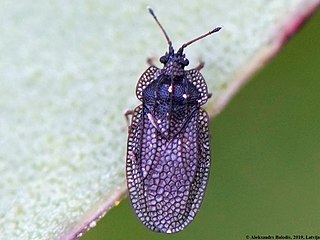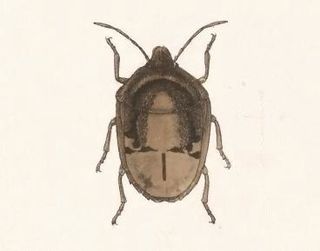
Scutelleridae is a family of true bugs. They are commonly known as jewel bugs or metallic shield bugs due to their often brilliant coloration. They are also known as shield-backed bugs due to the enlargement of the thoracic scutellum into a continuous shield over the abdomen and wings. This latter characteristic distinguishes them from most other families within Heteroptera, and may lead to misidentification as a beetle rather than a bug. These insects feed on plant juices from a variety of different species, including some commercial crops. Closely related to stink bugs, they may also produce an offensive odour when disturbed. There are around 450 species worldwide.

Macrotylus is a genus of plant bugs in the family Miridae. There are at least 60 described species in Macrotylus.

Orthops is a genus of plant bugs in the family Miridae. There are at least 30 described species in Orthops.

Acalypta is a genus of lace bugs in the family Tingidae. There are at least 50 described species in Acalypta.

Kalama is a genus of lace bugs in the family Tingidae. There are at least 30 described species in Kalama.

Orthocephalus is a genus of plant bugs in the family Miridae. There are more than 20 described species in Orthocephalus.

Orsilochides is a genus of shield-backed bugs in the family Scutelleridae. There are at least three described species in Orsilochides.
Acantholomidea is a genus of shield-backed bugs in the family Scutelleridae. There are at least two described species in Acantholomidea.
Diolcus is a genus of shield-backed bugs in the family Scutelleridae. There are at least three described species in Diolcus.

Halticus is a genus of fleahoppers in the family Miridae. There are at least 20 described species in Halticus.

Tetyra is a genus of shield-backed bugs in the family Scutelleridae. There are about seven described species in Tetyra.

Sphyrocoris is a genus of shield-backed bugs in the family Scutelleridae. There are at least two described species in Sphyrocoris.

Symphylus is a genus of shield-backed bugs in the family Scutelleridae. There are at least four described species in Symphylus.

Galeatus is a genus of lace bugs in the family Tingidae. There are about 18 described species in Galeatus.

Augocoris is a genus of shield-backed bugs in the family Scutelleridae. There are at least two described species in Augocoris.
Euptychodera is a genus of shield-backed bugs in the family Scutelleridae. There is one described species in Euptychodera, E. corrugata.
Fokkeria is a genus of shield-backed bugs in the family Scutelleridae. There is one described species in Fokkeria, F. producta.

Megalocoleus is a genus of plant bugs in the family Miridae. There are about 18 described species in Megalocoleus.
Vanduzeeina is a genus of shield-backed bugs in the family Scutelleridae. There are about five described species in Vanduzeeina.

Dictyonota is a genus of lace bugs in the family Tingidae. There are more than 60 described species in Dictyonota.















